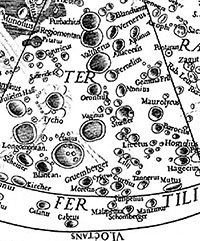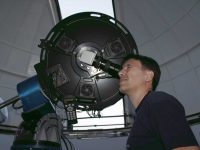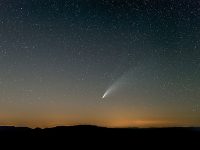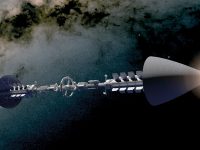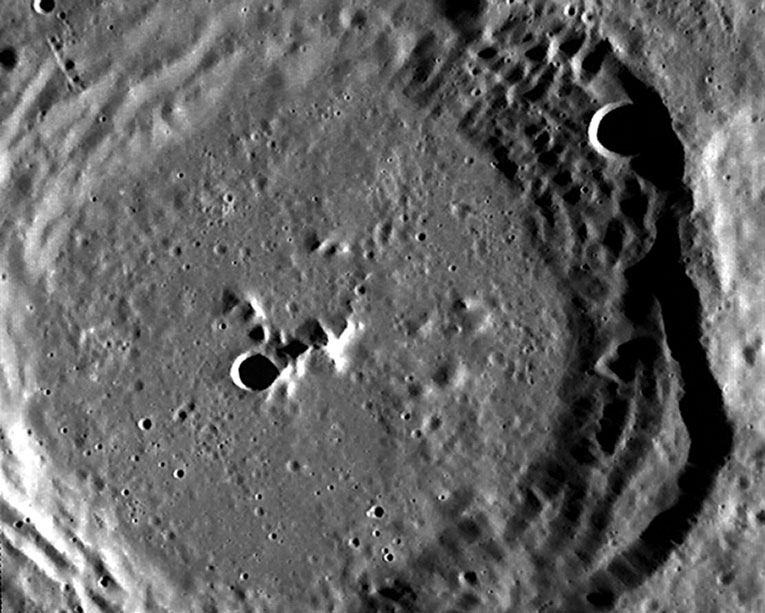 © NASA/Johns Hopkins University Applied Physics Laboratory/Carnegie Institution of Washington. Picture of the Ausiàs March crater in Mercury obtained by the Messenger mission. |
|||
|
The first Europeans to ever arrive in America found a new word but they did not know its toponymy. The conquerors, not very refined people, didn’t ask the natives for the names of their rivers, bays, mountains and plains. To give them a name was, somehow, to appropriate them. But, what happens when mountains, volcanos, craters, etc. have never been given a name? This was the case of the geographical features in the Moon since the invention of the telescope and of the planets and satellites since space exploration began. And who gives a name to the mountains and craters of the Solar System once they are discovered? AN UNEXPECTED DISCOVERY: AUSIÀS MARCH IN MERCURY While preparing a talk about lunar nomenclature for the Fabra Observatory in Barcelona, and going over the database of planetary names in the webpage of the USGS (United States Geological Survey), one of us —Carles Duarte— found with surprise that Mercury has, since 1979, a crater dedicated to Ausiàs March. Who would be so nice so as to honour the Valencian poet with this naming? The answer was found by the other author of this writing —Enric Marco—, after having contacted Jennifer Blue, the current manager of the planetary databases in the USGS. This scientist assured us that it was David Morrison who promoted it. Xavier Aliaga wrote a passionate article in Quadern (in El País) in order to spread the word of the discovery. We knew the identity of the person, but we didn’t know why he chose the name of Ausiàs March for one of the craters, nor the general criterion followed for the assiginment of names in the geography of Mercury. The names of the planetary features are not given at random. They follow a criterion previously agreed about an specific topic, generally related to the diety associated to the planet, and always reminding all cultures in the world. However, it has not always been like that, as we will see, in the case of lunar nomenclature. Lunar toponymy emerged with the first attempts to draw maps of the Moon with the invention of the telescope. |
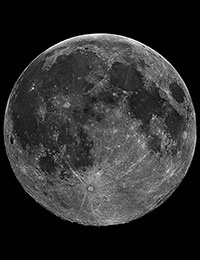 © NASA With the advent of the telescope arose the necessity of naming the different craters, seas and mountains in the Moon. «Recently, Carles Duarte— found with surprise that Mercury has, since 1979, a crater dedicated to Ausiàs March. Who would be so nice so as to honour the Valencian poet with this naming?»
|
||
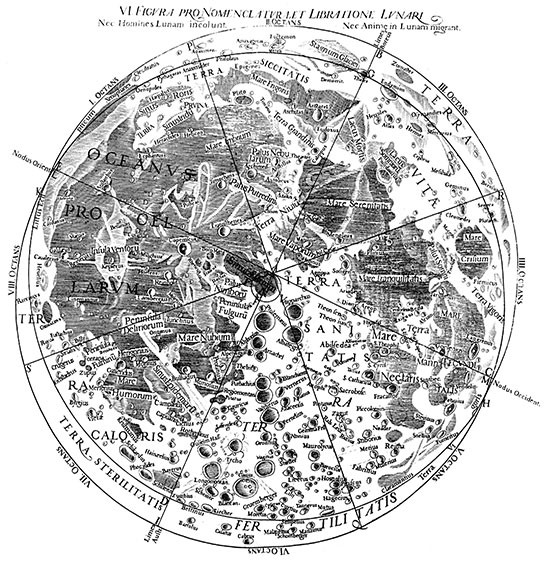 © MÈTODE © MÈTODEThe map of the Moon by Riccioli was the first one to apply a coherent criterion in the naming of the lunar features Most of these names are still used today. |
«The names of the planetary features are not given at random. They follow a criterion previously agreed about an specific topic, generally related to the diety associated to the planet» |
||
|
SOME HISTORY The first drawings of our satellite we know of were made by Leonardo da Vinci between 1505 and 1508. The general appearance of the lunar seas was clearly visible, but they had no name. In 1600, William Gilbert, doctor of the queen Elizabeth I and discoverer of the magnetic field of the Earth, made a drawing, not very neatly done, and gave name to the seas for the first time. Britania was the name of the currently Sea of the Crises, while the Sea of Showers was named Regio Magna Orientalis. This pretelescopic nomenclature did not stand the battering of the first lunar maps, made with the optic aid of the telescope. Now we know that the Englishman Thomas Harriott was the first one to observe the Moon with a telescope on the 5th of August of 1609, four months earlier than Galileo Galilei. But it wasn’t until 1611 that he published his lunar map where he gave numbers and letters to the different forms he discovered. On the 30th of November of 1609, Galileo Galilei observed and made drawings of the Moon, nevertheless, unlike Harriott, interpreted what he had seen as mountains, seas and craters. The man form Tuscany, who was a mathematician and an expert on perspective, discovered shadows and reliefs where Harriott had only seen flat forms. Selenography actually began with Michael Florent van Langren and his map was the first hand-written, and later published in engravings since 1645. As the cosmographer of king Philip IV of Spain and a flatterer courtier, he named seas and craters after members of the European nobility and royalty —for example Philip IV, Austrian Sea or Borbonic Sea. But he also used the names of philisophers, scientists and explorers. There are 325 names, most of which disappeared, remaining only Langrenus, Endymion and Pythagoras. From a cartographic point of view, and even more decisive from the point of view of nomenclature, it is more relevant the contribution of the maps Almagestum novum of the jesuit priest Ferrara Giovanni Battista Riccioli in 1651. From his observatory in Bologna, this astronomer and physicist built an enormous net of collaborators throughout Europe, especially jesuits. In Riccioli’s maps, we find, for the first time, a coherent criterion for the naming of lunar features. Lands and seas were given names with an astrological medieval taste like Sea of the Crises, Sea of Showers, Sea of Nectar, Sea of Fecundity or Sea of Tranquility. Craters were given the names of ancient and modern philisophers and astronomers. For example Archimedes, Aristarchus, Aristotle, Copernicus, Plato, Tycho, Eratosthenes, Kepler, Galileo, Alphonsus or Grimaldi, his disciple. The crater Mutus, near the lunar South Pole, was named after the astronomer and military engineer from Mallorca Vicenç Mut, and Munosius after the 16th century Valencian astronomer Jeroni Muñoz. Most of these names remain today; others, like Munosius, were later replaced by someone else’s name. Johann Heinrich Mädler, from Wilhelm Beer’s observatory, devoted himself to the observation of Mars, and draw its first real map, but he also studied the Moon. He made the first exact map of our satellite, which was published in four volumes, from 1834 to 1836, named Mappa Selenographica. This volume, which was not improved until four decades later, incorporates 133 new names of astronomers, geographers, mathematicians and naturalists. Besides, Beer and Mädler established the system of naming the secondary craters with a letter associated to a near crater. Most of later cartographers used this method. THE ADVENT OF PHOTOGRAPHY The last lunar map to be drawn and the more carefully kept before the advent of photography is La Charte der Gebirge des Mondes, by Julius Schmidt, published in 25 pages in 1878. With an infinite patience he drew 32.856 craters and added 76 new names to the geographical features. Everything changed then, when photogrpahy burst into astronomy adding objectivity to the observations. Julius Franz and Samuel A. Saunder made major works with the support of photographic plates. It was then that Saunder thought of the necessity of revising and systematising lunar nomenclature. A woman, however, turned out to be essential for this arid task. The English Mary A. Blagg had studied German and algebra, and in a university extension course got interested in astronomy. Her teacher suggested her to devot herself to the development of a coherent system for lunar nomenclature. Together with Saunder she finished Collated List of Lunar Formations in 1913. She was the first woman elected to be a member of the prestigious Royal Astronomical Society in 1916. In 1920, Blagg became a part of the Lunar Comission of the recently created International Astronomical Union (IAU),and, together with Karl Müller, worked intensively on the standardization of the lunar nomenclature. The result was Named Lunar Formations (1935), published in two volumes, accepted at the international level. No important modification has been made ever since. Only, from 1948 to 1955, P. Wilkins together with P.A. Moore and the Catalan astronomer Antoni Paluzie, secretary of the International Astronomical Union, proposed to the IAU a list of names for smaller craters named until then with letters. There were in the list around thirty names of Spanish scientists like Jorge Juan, Josep Comas i Solà, Josep Joaquim Landerer or Paluzie himself. However, none of them was accepted. The success of the Soviet space probe Lunik 3, which took photographs of the far side of the Moon in 1960, made it necessary to find names for the new-found geogrphical features. Thus, craters in and around Mare Moscoviense were named after deceased Russian cosmonauts, while the names of deceased American astronauts were used for the area around crater Apollo. The fact is that the IAU had already aproved some recommendations in 1961for a consistent and systematic nomenclature of the lunar geopraphy. Later on, planetary exploration forced the IAU to systematise a planetary nomenclature. |
|
«In the Moon and Mars astronomers and scientists are honoured, and David Morrison defended that we had to break away from this tradition and name the main craters in Mercury after people from the world of literature like Ausiàs March» |
|
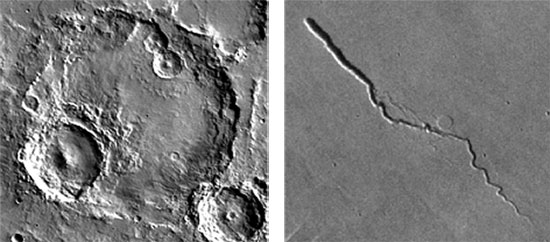 © NASA, Viking, Mola imagery, USGS On the left, the crater Comàs i Solà in Mars, named after the Catalan astronomer. This name was given following the criterion of giving the names of scientists and writers who had contributed to the popularisation of the planet to the larger craters in Mars. On the right, Iberus Vallis, after the river Ebro, in Mars. It was decided that smaller valleys in Mars would be named after rivers from the Earth. |
«It was decided that in Mars craters would be given the names of dead scientists or of writers who had contributed to the popularisation of Mars, like Schiaperelli or H.G. Wells» | ||
|
THE TOPONYMY OF MARS Brad Smith, an astronomer who had worked on some of the Mariner exploration missions of Mars and on the coordination of the working group that gives official names to he new-found features, stated very clearly in 2005 the purpuse of scientists in an interview: «It is too hard to argue about that volcano on the left or that other on the right. People like givng names to their pets, not just saying: “hey, you!” or “you, dog!”» It was decided that in Mars craters would be given the names of dead scientists or of writers who had contributed to the popularisation of Mars, like Schiaperelli or H.G. Wells. Towns under 100.000 inhabitants would be the source for the names of the smaller craters. The larger valleys would be named using the name of Mars in different languages, while smaller valleys would be named after rivers from the Earth. No feature under 100 metres would be given an official name unless it was of an exceptional scientific interest. Within the Catalan speaking-area we find the craters Comàs Solà, with a diameter of 127 km; Isil, with 82 km, after the small town of Les Valls d’Àneu, in Pallars Sobirà. We also find valleys named Iberus Vallis (after river Ebro) or Tader Valles (after river Segura). However, the arrival in Mars of the explorer robots Spirit and Opportunity in 2004 forced the members of the group to use unofficial names for the smaller craters or rocks studied — Sponge Bob, Abba or Bee Gees, for instance. VENUS, THE PLANET OF WOMEN In Venus, the dense atmosphere hinders direct observation of the surface from the Earth. The 300 metre radiotelescope in Arecibo, however, got to find two new very reflective areas —Alpha and Beta Regio— and a bright area— Maxwell Montes. Up until the arrival of the mission Magellan —which had the task of studiying its atmosphere and mapping its surface— nothing else was known. Between 1990 and 1992 the on-board radar got to map 98% of its surface, covered a great deal by volcanic materials and structures. A lot of volcanos were found, but, in contrast to the Moon, very few impact craters. Its surface, therefore, is young and continually renewed with not too viscous lava flows that run through channels of planetary dimensions. It had to be created a new working group in the IAU for the new geological structures without a name which asked for international collaboration. Since Venus is the goddess of beauty, it was decided that its geographical features would be given names related to goddesses (fertility, war, beauty, etc.). Craters larger than 20 km, however, would be named after dead women who contributed greatly to their working fields. Common women names would be used for smaller craters. Famous women from Castille, like Isabella “the Catholic queen” or the physician and educator from the 15th century Beatriz Galindo —known as La Latina, are also acknowledged and have their names given to a crater. The only woman from the Catalan speaking-area we find is the Spanish dancing dancer from Barcelona Carmen Amaya, very well-knwon in the USA, where appeared in some films and even danced for president Roosevelt. |
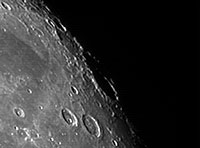 © Carles Duarte i Montserrat Crater Endymion, Selene’s lover, on the north-eastern part of the Moon. «In Mars we find the craters Comàs Solà, with a diameter of 127 km; Isil, with 82 km, after the small town of Les Valls d’Àneu, in Pallars Sobirà. We also find valleys named Iberus Vallis (after river Ebro) or Tader Valles (after river Segura)» |
||
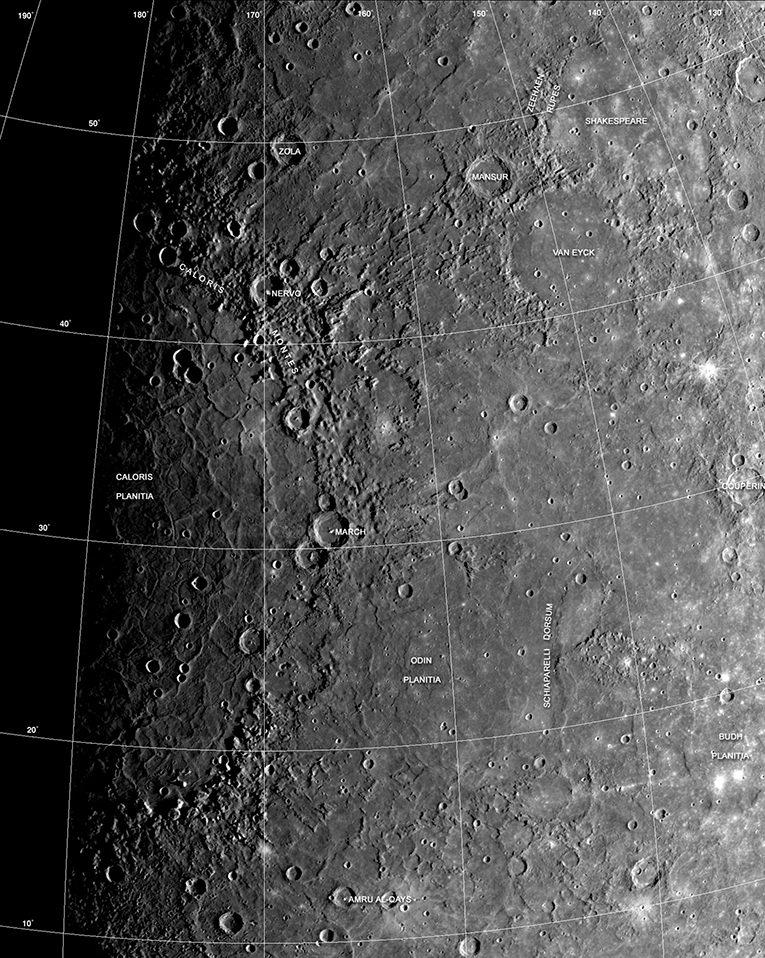 © NASA Caloris Basin in Mercury, close to the Ausiàs March crater. |
|||
|
A MATTER OF NAMES Planets are named after the main Roman gods. In order to give a name to the elements of the geography of the planets we only have to extend the tradition to the relationship among the gods or use the names of equivalent gods of other cultures. However, this source is limited. We have to look for other sources. This is the case of Miranda, one of Uranus’ satellites, daughter of the duke Prospero from The Tempest, by William Shakespeare. Its geogrpahical features’ names honour the characters and towns of Shakespeare’s work. The probe Mariner 10 flew over Mercury three times between 1974 and 1975. Its images revealed a planet full of impact craters, similar to the Moon. It was in 1973 when the IAU created the Working Group for Planetary System Nomenclature (WGPSN). There were created working subgroups for each planet or satellite. The conclusions of each of the groups, if aproved by the WGPSN, had to be confirmed by the general assembly of the IAU, which was held every two years. The group in charge of Mercury was directed by David Morrison— investigator of the NASA Astrobiolocal Institute, who was internationally known. As he himself told in an interview to the e-journal Cabinet in 2007, the aim of creating a database of names with an international representation was achieved in less than a year. Currently, David Morrison, already retired, is the director of the Carl Sagan Center from the Search for Extraterrestrial Intelligence Institute (SETI) in California. At the beginning of October 2011, the journal Vilaweb had an interview with him. «We thought of a wide range of possibilities for the names of the impact craters; from great astronomers to birds. In the maps of the Moon and Mars astronomers and scientists are honoured, and I defended that we had to break away from that tradition and name the main craters in Mercury after people from the world of the arts and literature —authors, painters, sculptors, poets, architects, etc.» But the working group didn’t know enough about these fields, «especially from an international perspective», and Morrison explained that «that is why reference works and univeristy researchers had to be consulted in order to elaborate a list of possible names». In 1979 the group lead by Morrison aproved the incorporation of the name of Ausiàs March to the list, but said: «I don’t remember who suggested Ausiàs March, but all in the group recognised it was a good suggestion as an important writer of the Catalan language». As confesed to Jennifer Blue, from the USGS, answering to why the name of Ausiàs March for the crater, « I wanted to be sure of having Catalan and Castilian writers represented in the craters of Mercury». Enric Marco Soler. PhD in Physics. Senior Research Technician in the Department of Astronomy and Astrophysics, University of Valencia. Specialist in the field of Astronomy in Diccionari de l’Institut d’Estudis Catalans, DIEC2. |
Recommendations for the nomenclature of the lunar geography of the general assembly of the IAU (1961) |
||
BIBLIOGRAPHY
Aliaga, X., 2001. «La fama d'Ausiàs March arriba a Mercuri». «Quadern», El País, 29 September 2011.
Ballesteros, F. & B. J. Luque, 2011. 10.000 años mirando estrellas. Alianza Editorial. Madrid.
Crespo, M., 2011. «Ausiàs March, de Gandia a Mercuri». Vilaweb, 13 October 2011.
Navarro Brotons, V. (ed.), 2009. Vicenç Mut i Armengol (1614-1687) i l'astronomia. Govern de les Illes Balears. Palma.
Paluzie Borrell, A., 1969. Las maravillas del cielo. Danae. Barcelona.
Whitaker, E. A., 1999. Mapping and Naming the Moon, a History of Lunar Cartography and Nomenclature. Cambridge University Press. Cambridge.

